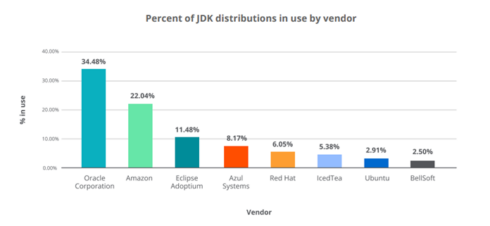
Oracle may be the stewards of the Java programming language, but their market share in Java Development Kit (JDK) distributions has significantly dropped over the past two years.
This is according to New Relic’s 2022 State of the Java Ecosystem report, which draws data from applications reporting to New Relic.
According to the survey, Oracle is responsible for 34.48% of the JDK distributions that are currently in use today. Back in 2020, Oracle had roughly 75% of the share of the market, so this is a big change.
As Oracle’s market share has gone down, Amazon’s has gone up. In 2020, only 2.18% of the JDK distributions were provided by Amazon, but now they provide 22.04% of JDK distributions.
“The real interesting item is the rise of Amazon as a major provider and I would speculate that this is related to the use of containers,” Steve Poole, developer advocate at Sonatype, told SD Times. “When choosing any software for production the need for support is a major influence. Keeping the number of support vendors to a minimum is always wise too, so I speculate that the rise of Amazon Java is because it’s considered the safest option for deploying Java in containers to AWS.”
Oracle had switched to a more restrictive licensing of its JDF distribution for Java 11, which may be a factor. It has since opened up its license policy to be less restrictive for Java 17; however, Java 11 is currently the most used Long-Term Support (LTS) version of the language.
Forty-eight percent of Java users are using Java 11 while less than 1% use Java 17. The second most-used LTS version is Java 8, with 46.45% of Java users on it.
When it comes to non-LTS versions, Java 14 is the most popular, with 0.95% of use. Adoption of non-LTS versions of Java is extremely low, with only 2.7% of applications using one. This is likely because most vendors don’t ship patches for these versions.
“The expectation has been that Java 8 would continue to be highly popular for some time and that it would grow a little as those on earlier releases moved up to 8 but no further. Again, the adoption of 11 as the first choice for those who have moved on from 8 is unsurprising. The Java runtime is a vital element and staying on the LTS offers stability and support when needed. Using other non-LTS releases might be attractive occasionally but most will not want to take the risk in production,” said Poole.






